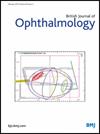影响高度近视青光眼严重程度的因素
IF 3.5
2区 医学
Q1 OPHTHALMOLOGY
引用次数: 0
摘要
目的探讨高度近视开角型青光眼(OAG)患者视神经头(ONH)参数与青光眼严重程度的关系。方法选取2022年1月至2023年12月接受眼科检查的高度近视OAG患者132例(132眼)进行横断面研究。根据国际疾病分类第10条标准将患者分为轻度、中度和晚期青光眼组。测量ONH参数,包括椎间盘面积、倾斜角度、β区和γ区乳头旁萎缩(PPA)面积和网状膜(LC)指标。使用方差分析比较这些参数在不同严重程度组之间的差异。进行Pearson相关和线性回归分析,调整轴长(AXL)。采用结构方程模型(SEM)探讨ONH参数与青光眼损伤之间的关系。结果轻度、中度和晚期青光眼组分别为31例、42例和59例。轻度组AXL短于其他两组(26.29 (0.85)mm vs 27.35(1.35)和27.07 (1.17)mm;p=0.001),肝盘椭圆度指数、倾斜角度、β区PPA面积、β区PPA与肝盘面积之比、PPA径向范围均较低(p<0.05)。多因素回归显示β区PPA面积与神经节细胞-内丛状层(GCIPL)平均厚度相关(β= - 1.162, p=0.029)。扫描电镜发现了椎间盘倾斜角度、LC深度、GCIPL变薄和视野丧失之间的重要联系。结论轻度组ONH变形较小,AXL较短。回归分析和扫描电镜分析都支持ONH结构改变——特别是β区PPA和椎间盘倾斜——在影响高度近视眼青光眼损伤中的作用。如有合理要求,可提供资料。本文章由计算机程序翻译,如有差异,请以英文原文为准。
Factors influencing glaucoma severity in highly myopic glaucoma
Aims To investigate optic nerve head (ONH) parameters in highly myopic individuals with open-angle glaucoma (OAG) and their associations with glaucoma severity. Methods A total of 132 patients with highly myopic OAG (132 eyes) who underwent ophthalmic examinations between January 2022 and December 2023 were included in this cross-sectional study. Patients were categorised into mild, moderate or advanced glaucoma groups based on the International Classification of Diseases 10th criteria. ONH parameters were measured, including disc area, tilt angle, β-zone and γ-zone parapapillary atrophy (PPA) areas and lamina cribrosa (LC) metrics. These parameters were compared across severity groups using analysis of variance. Pearson’s correlation and linear regression analyses were conducted, adjusting for axial length (AXL). Structural equation modelling (SEM) was performed to explore pathways among ONH parameters and glaucomatous damage. Results The mild, moderate and advanced glaucoma groups comprised 31, 42 and 59 patients, respectively. The mild group showed shorter AXL than the other groups (26.29 (0.85) vs 27.35 (1.35) and 27.07 (1.17) mm; p=0.001) and exhibited lower disc ovality index, tilt angle, β-zone PPA area, β-zone PPA-to-disc area ratio and PPA radial extent (all p<0.05). Multivariate regression revealed the association of β-zone PPA area with average ganglion cell–inner plexiform layer (GCIPL) thickness (β=−1.162, p=0.029). SEM identified a significant pathway linking disc tilt angle, LC depth, GCIPL thinning and visual field loss. Conclusion Mild group showed less ONH deformation and shorter AXL. Both regression and SEM analyses support the role of ONH structural changes—particularly β-zone PPA and disc tilt—in influencing glaucomatous damage in highly myopic eyes. Data are available upon reasonable request.
求助全文
通过发布文献求助,成功后即可免费获取论文全文。
去求助
来源期刊
CiteScore
10.30
自引率
2.40%
发文量
213
审稿时长
3-6 weeks
期刊介绍:
The British Journal of Ophthalmology (BJO) is an international peer-reviewed journal for ophthalmologists and visual science specialists. BJO publishes clinical investigations, clinical observations, and clinically relevant laboratory investigations related to ophthalmology. It also provides major reviews and also publishes manuscripts covering regional issues in a global context.

 求助内容:
求助内容: 应助结果提醒方式:
应助结果提醒方式:


